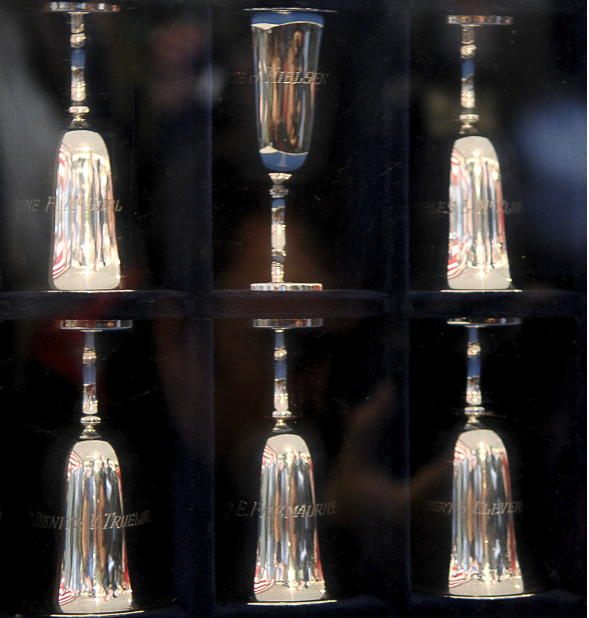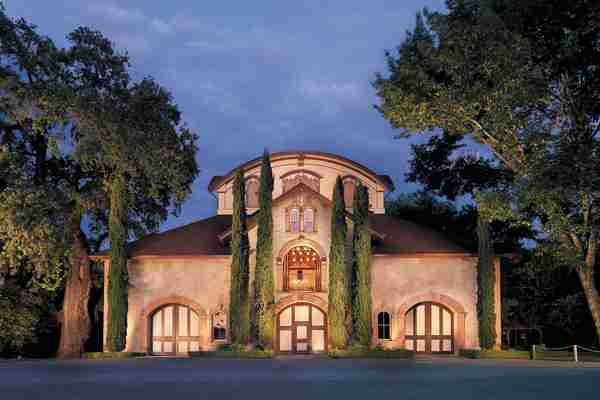doolittle raiders goblets
The Doolitte Raiders Goblets are not just wine glasses. They’re heroes. And I’m not crying. I’m saying thank you.
We’re really into all things history over here especially wine and war history. And if it’s a World War II war story pass the tissues.
The Greatest Generation sits on a pedestal in my book.
Last week, I had the opportunity to walk through the National Museum of the US Air Force in Dayton, Ohio. I love history, but aviation history, I’m working on it.
Old plane. Old plane. Big plane. Little plane. Plane with dots. Plane with spots. Bunch of silver wine goblets.
Wait. What? Wine goblets!? This just got interesting.
Doolittle Raiders
After trying to coax a decent picture out of my iPhone camera, I spent the next half an hour reading about Doolittle’s Raid and the 80 sterling silver wine goblets standing in front of me.
The Doolittle Raid in April of 1942 marked the first time US forces struck Japanese “home” islands in WWII.
The raids showed that Japan, too, was vulnerable to attack, and gave US forces a much needed morale boost. Not to mention a little retaliation for Pearl Harbor.
The Doolittle Raider’s Strategy
How’d they pull it off? With no friendly airfields close enough to Japan to launch an attack, 16 US Army Air Forces B-25 bombers were modified so they could be launched from an aircraft carrier.
Launching a bomber off an aircraft carrier in 1942 was one part crazy and two parts cajones.
The plan was to bomb strategic targets in Japan and then land in China because they wouldn’t have enough fuel to return to the Hornet.
Let that sink in for a minute. They wouldn’t have enough fuel to return. That’s a one-way ticket. And 80 men volunteered for the mission. 80 crazy men with cajones.
The Japanese got a whiff of the plan, so the pilots were told they would have to launch from even farther out in the Pacific Ocean and execute their raid without the cover of darkness.
Reaching China for any kind of landing, crash or otherwise, would be unlikely. They went anyway.
They went anyway.
The Doolittle Raid- Against All Odds
And so on April 18, 1942, 16 aircraft were launched from the USS Hornet in the Pacific, with 5 crew members aboard each.
All 16 aircraft hit their targets in Japan. And against all kinds of craptastical odds, 15 aircraft reached China and one made it to the Soviet Union.
All but 3 of the crew survived the crash landings. Eight crew members were captured by the Japanese in China, and three of those men were executed.
And btw, the Japanese killed over 250,000 (yes, that comma is in the right place) Chinese civilians as reprisal for sheltering the American pilots.
Twelve of the surviving Raiders would be killed in action later in World War II. All in all, 62 Raiders survived the war.
In 1944, MGM made a movie about the raid — Thirty Seconds Over Tokyo, starring Spencer Tracey. That’s going in my Netflix queue.
In April of 1946, General James “Jimmy” Doolittle and his Raiders gathered to commemorate the raid and remember the fallen Raiders.
How The Doolittle Raiders Goblets Came To Be
That event became an annual reunion and remembrance. In 1959, the city of Tuscon, Arizona commissioned 80 sterling silver goblets to honor the men of Doolittle’s Raid. Doolittle Raiders Goblets.
Each each of the Doolitle Raiders Goblets is engraved with the name of one of Doolittle’s Raiders.
The names are engraved on each goblet twice, so they can be read right side up or upside down.

At every reunion, surviving Doolittle Raiders have a Goblet Ceremony. They offer a toast: “To the men who gave their all in the success of our mission, and to those who have joined them since.”
They then turn the deceased’s goblet upside down (making it look more like a hand-bell). The symbolism gives me chills.
The original plan was for the last two Raiders to drink the bottle of 1896 Hennessy VSOP Cognac stored in the middle of the goblet case (special because it is the year of James Doolittle’s birth) and raise a final toast their fallen comrades.
In a Circle of Life moment, the Doolittle Raiders held their last public reunion in April 2013, at Eglin AFB in Florida (Eglin was where the Raiders trained in secret for their mission in 1942).
Three of the four remaining Raiders were able to attend, and they turned over one more goblet — another Raider gone, but not forgotten.
A final moment in solitude . . . to remember.
Lt. Col. Richard E. “Dick” Cole, the last surviving member of the Doolittle Raid, died in 2019 at age 103.
On April 18, 2022—the 80th anniversary of the raid—a final goblet ceremony was held to remember Cole and his fellow Doolittle Raiders.
And so, as I stood there in front of 80 sterling silver sentinels, drenched in history and symbolism . . . my eyeballs started leaking.
Naturally, that was the exact moment my teenage son decided to catch up to me. “Why are you crying about wine glasses, Mom? Did the wine spill or something?”.
They’re not just wine glasses . . . they’re heroes. And I’m not crying . . . I’m saying thank you.
Doolittle Raiders Goblets FAQ
When was Doolittle Raiders last toast?
On April 18, 2022—the 80th anniversary of the raid—a final goblet ceremony was held to remember Cole and his fellow Doolittle Raiders. And so, as I stood there in front of 80 sterling silver sentinels, drenched in history and symbolism . . . my eyeballs started leaking.
Where are the Doolittle Raiders goblets?
In 2005 the surviving Doolittle Raiders decided to make the National Museum of the United States Air Force the permanent home for these historic goblets.
Are there any Doolittle Raiders left?
Cole remained in China after the raid until June 1943, and served again in the China Burma India Theater from October 1943 until June 1944. He later served as operations advisor to the Venezuelan Air Force from 1959 to 1962. He retired from the Air Force in 1966 and became the last living Doolittle Raider in 2016.
Did any Doolittle planes survive?
Sixteen planes and 80 airmen executed the Doolittle Raid, 18 April 1942. With one exception – the plane piloted by CAPT Edward J. York – none of the planes made a proper landing: all either were ditched, or crashed after their crews bailed out. Nonetheless, all but three men survived the flight.
How many of Doolittle’s Raiders made it to China?
During the operation, which Lieutenant Colonel James Doolittle planned and led, 16 aircraft launched from the carrier USS Hornet and bombed targets in Japan, and 13 of the aircrews reached safety in China afterward.










